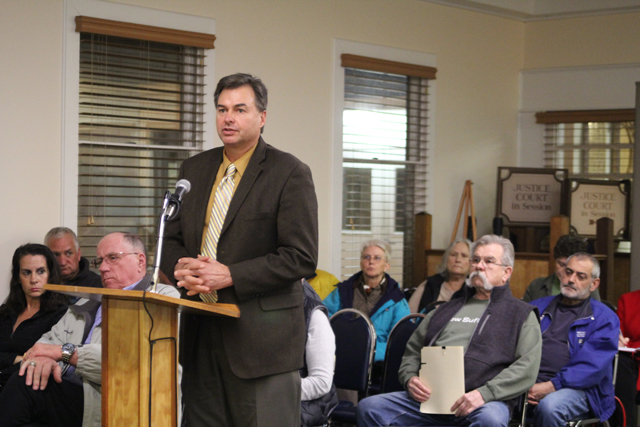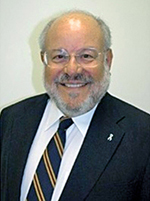Suffolk Closeup: Getting to know Al Krupski


Al Krupski is a man of the land of Long Island — a fourth-generation farmer. He’s a champion of open space and farmland preservation. And he well understands the importance of the water table below the land’s surface — the sole source aquifer on which Long Islanders (and Shelter Islanders, too) depend as their only potable water supply.
He knows the shoreline, too, as a member for two decades, including 14 years as president, of the Southold Town Board of Trustees, with jurisdiction over the town’s coast and waters fronting it.
Mr. Krupski is now a Suffolk County legislator and in that position has been bringing up issues not raised frequently enough in these parts.
He is concerned about the main way treated sewage is dealt with — pumped out into the ocean and Long Island Sound. This reduces freshwater from the aquifer and also opens the way for salt water intrusion, he warns. He advocates recharge of treated effluent back into the aquifer.
This is something that was heard over and over again in the 1960s and 70s as Suffolk County embarked on building the Southwest Sewer District with a design based on sending 30 million gallons a day of sewage through an outfall pipe into the Atlantic. Now Suffolk County government in projects being advanced by County Executive Steve Bellone would substantially add to the area covered by the Southwest Sewer District — and send yet even more millions of gallons daily out into the ocean.
As to the shoreline, Mr. Krupski challenges the notion of “armoring” the coast — placing hard structures on it hoping they will fend off an angry sea during storms. This is a prime strategy of the U.S. Army Corps of Engineers. Its most recent such undertaking is a $14.6 million project of armoring the coast in Montauk with “geotubes.”
And, meanwhile, the Corps is getting set to revive its more than half-century-old Fire Island Inlet to Montauk Point plan — now priced at $1.2 billion — originally predicated on constructing rock jetties or “groins” along the south shore oceanfront.
Mr. Krupski stresses how armoring of the coast causes erosion on the adjacent shore.
Years ago, there was great criticism of the Corps of Engineers constructing groins along the Westhampton shore — that, indeed, did enormous damage to the coast down-drift resulting in a lawsuit and an $80 million settlement with those affected (which, like the groins, was paid with taxpayer dollars.)
Last month, Mr. Krupski testified at a public hearing on “Water Quality and Contamination” of the New York State Senate and Assembly Committees on Health and Environmental Conservation held in Hauppauge.
He called on the state to “ramp up funding for land preservation” emphasizing that “if you limit development, you limit the amount of nitrogen and other contaminants entering our ground and surface waters … To do that effectively in Suffolk County we will need support in the form of funding from New York State.”
There are “not only issues of water quality but of quantity as well,” he continued. He spoke of how now “much” of the effluent from sewage treatment plants is sent into the ocean and Sound. “We are pulling water out of the aquifer, but we are not putting anything back into it and this can increase the risk of salt water intrusion into Long Island’s sole source of drinking water. Over time, this can dramatically change the dynamics of groundwater flow,” he said.
And, he said, “there needs to be a serious discussion” about coastal erosion and how to deal with it recognizing how it has been “exacerbated” by climate change, sea level rise and more frequent and intense storms.
“The relatively minor Tropical Storm Hermine caused significant damage to the recent and already costly downtown Montauk armoring project,” he testified. “We need to have the difficult conversation about whether we are going to continue to harden our shoreline, which can lead to numerous unintended and costly ramifications, or develop a sustainable public policy for shoreline management.”
In his personal as well as governmental life, Mr. Krupski has thought outside the box. He was recollecting the other day about when he was in high school and began raising pumpkins on the family farm in Cutchogue, which had stuck with potatoes. The farm soon ended potato dependence and today grows a wide diversity of produce.
After his long stint on the South-old Trustees, he served on the Southold Town Board, was deputy town supervisor, and became a county legislator in 2013 representing a district that encompasses Riverhead and Southold Towns.
On the sewage issue, he’s delighted that the Riverhead Sewage Treatment Plant last month, after a $24 million upgrade, began sending treated effluent on to the adjoining county golf course instead of into Flanders Bay, as was the practice for years. “The microbiology of the soil is pretty aggressive and will render the effluent harmless,” explained Mr. Krupski, who has a degree in plant science from the University of Delaware. The change “really sets an example.”
Al Krupski — a Suffolk public official most deserving of being listened to.
Mr. Krupski stresses how armoring of the coast causes erosion on the adjacent shore.
 Karl Grossman is a veteran journalist and professor and a member of the Press Club of Long Island’s Journalism Hall of Fame. His Suffolk Closeup column is syndicated in newspapers across the county.
Karl Grossman is a veteran journalist and professor and a member of the Press Club of Long Island’s Journalism Hall of Fame. His Suffolk Closeup column is syndicated in newspapers across the county.








